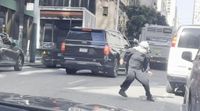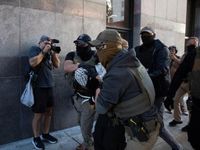On August 20, 2025, the streets outside the San Francisco immigration court at 100 Montgomery Street erupted into chaos, marking a new flashpoint in the ongoing national debate over immigration enforcement. What began as a routine day for Immigration and Customs Enforcement (ICE) agents quickly escalated into a confrontation with a group of 15 to 20 protesters—an incident that would leave federal officers injured, a protester in custody, and community groups across the city demanding answers.
According to multiple reports, including statements from the Department of Homeland Security (DHS) and eyewitnesses cited by Mission Local, the protest unfolded as ICE agents attempted to exit the courthouse with an individual in custody. Protesters, many masked and some wearing keffiyehs, physically blocked the agents’ path, chanting slogans like “ICE is not welcome in San Francisco!” and brandishing signs that read, “Stop your car to block ICE.” The standoff quickly turned tense. As the crowd pressed in, ICE officers deployed pepper spray to clear a path, but the confrontation spilled into the street, with activists continuing to shout and harass the agents as they made their way toward the ICE headquarters at 630 Sansome Street.
Amid the turmoil, one protester—identified alternately as Angelica or Adrian Guerrero, a 35-year-old trans woman and U.S. citizen—was singled out for actions that would soon make headlines nationwide. Court documents and DHS statements confirm that Guerrero, wearing a black-and-white keffiyeh and orange-tinted goggles, used a knife to slash the front tire of a government-marked Chevrolet van being used to transport a recently detained individual. Guerrero then allegedly turned the knife and her anger toward federal agents, issuing a series of threats that prosecutors later recounted in court: “I’m going to f**k you up,” “I’m going to go after your family,” and “I’m going to stab you.”
Video of the arrest, widely circulated on social media and reported by outlets such as Mission Local and KTVU, shows ICE agents tackling Guerrero to the ground, zip-tying her hands, and leading her away as supporters shouted in protest. The footage, along with photos of the slashed tire and the knife allegedly used, quickly became a focal point for both critics and defenders of ICE’s tactics.
Guerrero’s arrest marked a significant moment for San Francisco. Local attorneys interviewed by Mission Local noted that this was the first time in recent memory that Department of Homeland Security authorities had filed federal misdemeanor charges—specifically, destruction of property and assaulting, resisting, or impeding a federal officer—against a citizen in the city. Angela Chan, the city’s assistant chief public defender, called it an “escalation” of federal enforcement practices, especially given that similar charges had previously been more common in Los Angeles.
After her arrest, Guerrero was taken first to the ICE headquarters on Sansome Street, then to Santa Rita jail in Alameda County. According to her partner, Renee, Guerrero was held without access to a phone or attorney, and her family spent hours searching local jail logs before finally locating her name at midnight. The following morning, her name disappeared from the log, and supporters only learned of her scheduled court appearance at the federal courthouse on Golden Gate Avenue shortly before it was set to begin.
At her hearing, U.S. District Court Magistrate Judge Sallie Kim ordered Guerrero released pending her next court date in September, but imposed conditions: she must stay away from the immigration courts at both 100 Montgomery and 630 Sansome Streets. Federal prosecutors had sought a broader order barring her from all federal buildings and from approaching federal officers, but Judge Kim dismissed that as impractical, reportedly asking, “What is she supposed to do if she sees a uniformed federal officer—run away in the other direction?” The remark drew laughter from the gallery, highlighting the tension and, for some, the absurdity of the situation.
The incident has reverberated far beyond the courthouse steps. Labor, immigrant, queer, and trans community groups quickly rallied in support of Guerrero. Theresa Rutherford, president of the Service Employees International Union (SEIU) Local 1021, issued a statement expressing outrage: “SEIU 1021 members were outraged to learn that Angélica, a U.S. citizen and the child of one of our own members, was violently arrested by ICE in San Francisco while exercising her First Amendment rights.” Guerrero’s partner, Renee, added that she was “standing up for all the things the mayor says he supports, but has been silent on.”
Federal officials, meanwhile, painted a starkly different picture. The Department of Homeland Security, in a statement released on August 22, condemned what it described as a violent ambush on law enforcement, noting that four agents sustained injuries from pepper spray and physical altercations, including a jammed finger. Secretary Kristi Noem declared, “Our brave ICE law enforcement are now facing a 1,000% increase in assaults against them as they risk their lives to arrest the worst of the worst criminal illegal aliens. These acts of violence are fueled by sanctuary politicians’ rhetoric vilifying our law enforcement. We will not and have not let this violence stop us or slow us down.”
The broader context is hard to ignore. According to DHS, the assault on August 20 was part of a nationwide uptick in attacks against federal immigration agents. The agency cited similar incidents in other cities, including a July attack on an ICE detention center near Dallas, where armed assailants opened fire on agents and police. The debate over so-called “sanctuary cities” and the proper boundaries of protest versus enforcement continues to divide communities and policymakers alike.
For San Francisco, the events of August 20 have become a flashpoint, bringing longstanding tensions to a head. On one side, activists and community organizations see Guerrero’s arrest as an attack on the right to protest and a dangerous precedent for federal overreach in a city known for its resistance to ICE operations. On the other, federal officials and their supporters argue that the violence directed at law enforcement cannot be tolerated, regardless of political views or local policies.
As Guerrero awaits her next court appearance in September, both sides are watching closely. The outcome may shape not just her future, but also the evolving relationship between local activism, federal enforcement, and the rights of citizens caught in between. One thing is certain: the streets of San Francisco, long a battleground for the nation’s immigration debates, remain as contentious as ever.





